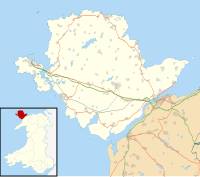
Back Anglesey Afrikaans Angleseġ ANG أنغلزي Arabic Англсі Byelorussian Ангълси Bulgarian Enez Mon Breton Ynys Môn Catalan Anglesey (pulo) CEB ئەنگلیسی CKB Anglesey Czech
Isle of Anglesey
Ynys Môn (Welsh) | |
|---|---|
Left to right:
| |
|
| |
 | |
| Sovereign State | United Kingdom |
| Constituent Country | Wales |
| County Council | Isle of Anglesey |
| Preserved County | Gwynedd |
| Admin HQ | Llangefni |
| Largest town | Holyhead (county) Llangefni (island) |
| Government | |
| • Type | Isle of Anglesey County Council |
| • Control | Plaid Cymru/Independent Coalition |
| • Member of Parliament | Virginia Crosbie, Con |
| • Member of Senedd | Rhun ap Iorwerth, PC |
| • Council Leader | Cllr Llinos Medi Huws, PC |
| Area | |
| • Total | 276 sq mi (714 km2) |
| • Rank | 9th |
| Population (2022) | |
| • Total | 69,049 |
| • Rank | 20th |
| • Density | 250/sq mi (97/km2) |
| • Rank | 17th |
| • Ethnicity | 98.1% White |
| Welsh language | |
| • Rank | 2nd |
| • Speakers | 55.8%[1] |
| Geocode | 00NA (ONS) W06000001 (GSS) |
| ISO 3166 code | GB-AGY |
| Website | www |
Anglesey (/ˈæŋɡəlsiː/; Welsh: Ynys Môn [ˈənɨs ˈmoːn]) is an island off the north-west coast of Wales. It forms the bulk of the county known as the Isle of Anglesey, which also includes Holy Island (Ynys Gybi) and some islets and skerries.[2] The county borders Gwynedd across the Menai Strait to the southeast, and is otherwise surrounded by the Irish Sea. Holyhead is the largest town, and the administrative centre is Llangefni. The county is part of the preserved county of Gwynedd.
The Isle of Anglesey is sparsely populated, with an area of 276 square miles (710 km2) and a population of 68,900.[3] After Holyhead (12,103),[4][failed verification] the largest settlements are Llangefni (5,500) and Amlwch (3,967). The economy of the county is mostly based on agriculture, energy, and tourism, the latter especially on the coast. Holyhead is also a major ferry port for Dublin, Ireland.[5] The county has the second-highest percentage of Welsh speakers in Wales, at 57.2%, and is considered a heartland of the language.[6]
The island of Anglesey, at 676 square kilometres (261 sq mi), is the largest in Wales and the Irish Sea, and the seventh largest in Britain. The northern and eastern coasts of the island are rugged, and the southern and western coasts are generally gentler; the interior is gently undulating. In the north of the island is Llyn Alaw, a reservoir with an area of 1.4 square miles (4 km2). Holy Island has a similar landscape, with a rugged north and west coast and beaches to the east and south. The county is surrounded by smaller islands; several, including South Stack and Puffin Island, are home to seabird colonies. Large parts of the county's coastline have been designated an Area of Outstanding Natural Beauty.
The county has many prehistoric monuments, such as Bryn Celli Ddu burial chamber. In the Middle Ages the area was part of the Kingdom of Gwynedd and native Principality of Wales, and the ruling House of Aberffraw maintained courts (Welsh: llysoedd) at Aberffraw and Rhosyr. After Edward I's conquest of Gwynedd he built the castle at Beaumaris, which forms part of the Castles and Town Walls of King Edward in Gwynedd World Heritage Site. The Menai Strait to the mainland is spanned by the Menai Suspension Bridge, designed by Thomas Telford in 1826, and the Britannia Bridge, originally designed by Robert Stephenson in 1850.
- ^ "How life has changed on Isle of Anglesey: Census 2021".
- ^ "Sir Ynys Mon – Isle of Anglesey". Ordnance Survey. Retrieved 29 November 2019.
- ^ "How life has changed on Isle of Anglesey: Census 2021". Office for National Statistics. Retrieved 27 November 2023.
- ^ "Build a custom area profile - Census 2021, ONS". www.ons.gov.uk. Retrieved 27 November 2023.
- ^ C. Michael Hogan (2011). "Irish Sea". In P. Saundry; C. Cleveland (eds.). Encyclopedia of Earth. Washington, D. C.: National Council for Science and the Environment.
- ^ "The Welsh language on Anglesey". www.anglesey.gov.wales. Retrieved 27 November 2023.
© MMXXIII Rich X Search. We shall prevail. All rights reserved. Rich X Search




